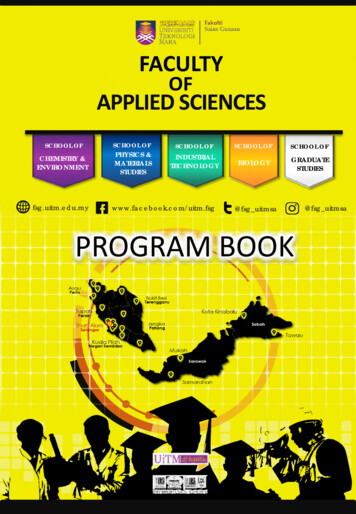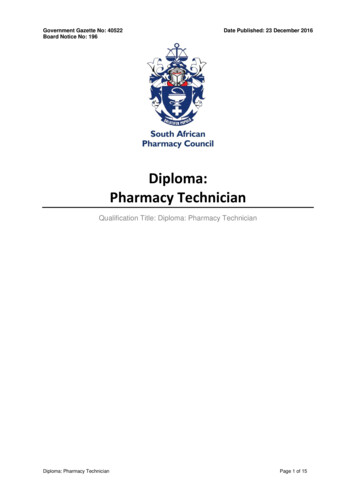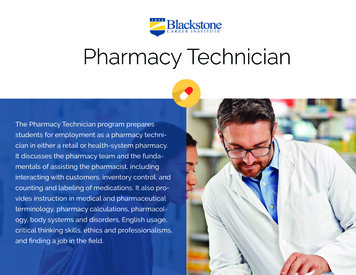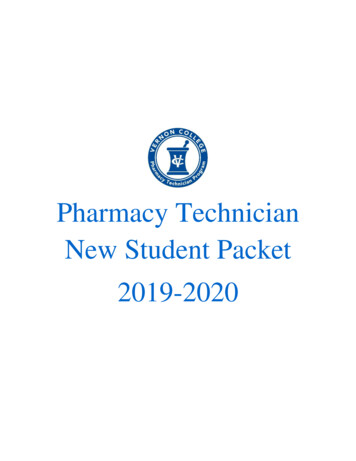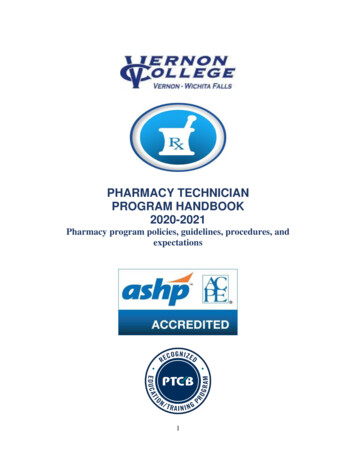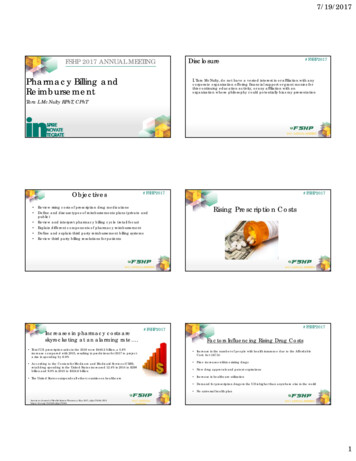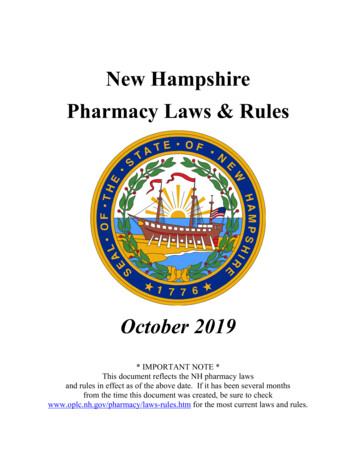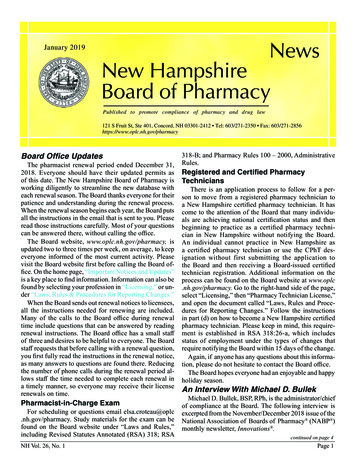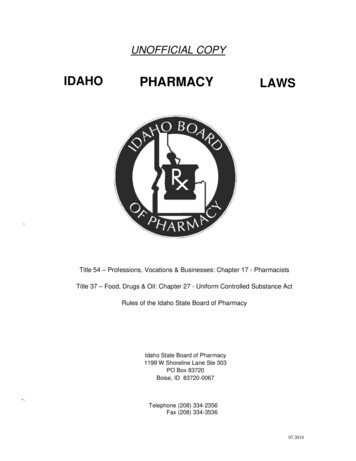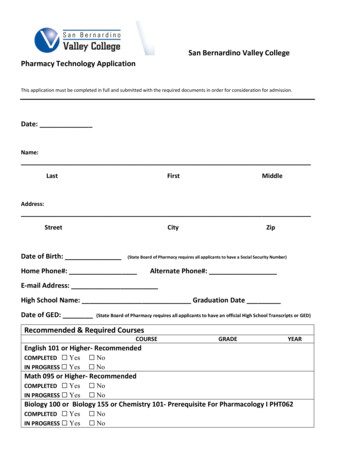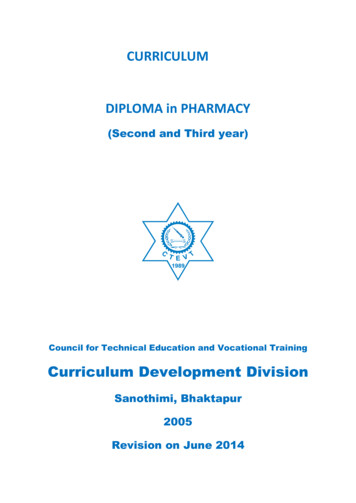
Transcription
CURRICULUMDIPLOMA in PHARMACY(Second and Third year)Council for Technical Education and Vocational TrainingCurriculum Development DivisionSanothimi, Bhaktapur2005Revision on June 2014
Table of ContentsIntroduction .3Mission of the Curriculum .3Strategy.3Philosophy .3Program Description.3Aims and Objectives .3Conceptual Framework .4Target Group.4Group Size.4Entry Criteria.4Medium of Instruction.4Course Duration.4Pattern of Attendance .4Teacher and Student Ratio .4Program Coordinator, Teacher and Demonstrator .5Instructional Media and Materials .5Comprehensive Professional Field Practice.5Teaching Learning Methodologies .5Disciplinary and Ethical Requirements .6Methods of Evaluation .6Pass Marks .6Grading System.6Certificate Award .7Career path .7Course Structure .8Second Year .9Pharmaceutics I .10Pharmacology & Pharmacotherapeutics I .15Pharmaceutical Chemistry I .18Pharmacognosy .22Biochemistry and Microbiology .25Pathophysiology .27Pharmaceutical Management .29Health Education & Health Care System .32Third Year .39Pharmaceutics II .40Pharmacology and Pharmacotherapeutics II .46Pharmaceutical Chemistry II .50Hospital and Clinical Pharmacy .53Social Pharmacy and Pharmaceutical Jurisprudence .56Pharmacoepidemiology and Environmental Health .59Comprehensive Professional Field Practice.68Curriculum Revision Team: . Error! Bookmark not defined.2
IntroductionThe Government of Nepal (GoN) is committed to bringing about tangible changes in access andutilization of Essential Health Care Services (EHCS), thereby improving the health status of theNepalese population through health sector development process. Access to health care facilitiescontinues to be a problem in rural areas as well as urban areas, especially for the mostdisadvantaged. Nepal’s health policy and strategy documents over the past several decadesrepeatedly identify issues regarding the deployment and retention of health sector human resourceas a major problem that our country is facing. The Council for Technical Education and VocationalTraining (CTEVT) has been contributing towards the development of different middle level ofhealth human resource. In this connection, CTEVT is producing Diploma in Pharmacyprofessional - as middle level pharmaceutical service providers. The CTEVT will award certificateof "Diploma in Pharmacy" to the candidates who successfully complete the requirements asprescribed by the council. The Diplomain Pharmacy professional will be able to work asPharmacy Assistant in the Community Pharmacy, Hospitals and other Pharmaceutical servicesproviding sites.Mission of the CurriculumTo provide the document which direct CTEVT schools and faculty in the process of educatingquality middle level pharmacy human resource to meet the requirements of pharmaceuticalservices in Nepal and abroad.StrategyThe strategies to achieve our mission of professional excellence will be attained by maintainingexpert faculty, implementing the curriculum, and enrollment of quality students.PhilosophyThe philosophy of the Diploma in Pharmacy curriculum should be based on the development ofpharmacy, as a profession for fulfilling the healthcare needs of the people with its socio-culturalimpact on health. It should be based on code of conduct of Nepal Pharmacy Council. The approachshould focus on pharmaceutical services for better health of the people.Program DescriptionThis course is based on the job required to perform by a pharmacy assistants at different levels ofpublic and private health institutions in Nepal. The Diploma in Pharmacy program extends overthree years. The first year focuses on basic science subjects; the second year focuses on basicmedical science and pharmaceutical sciences. Similarly, the third year focuses on the professionalpractice focus courses and application of acquired knowledge and skills through comprehensivefield practices in hospital, community pharmacies, drug manufacturing, regulation and qualityassurance. The professionals are eligible for registration as pharmacy assistants in the NepalPharmacy Council. The contents of individual subjects prescribed in the curriculum areincorporated in the light of skills required for professional practice.Aims and ObjectivesThe course aims to produce middle level pharmacy human resource with perfect technical skillsthat can face real life situation at the level they are aimed at.The course enables students: To prepare technically competent middle level pharmacy human resource who willdemonstrate excellent service attitude and respect for the profession and socio-culturalvalues.3
To develop middle level pharmacy human resource for good pharmacy practice in thehospitals as well as in the community settings.To demonstrate leadership in managing quality supply of pharmaceuticals and to promoterational use of medicine within the healthcare facilities and at the community pharmacies.To develop middle level pharmacy human resource in order to assist in production andquality assurance of pharmaceuticals.Conceptual FrameworkThe course should reflect: The need of pharmaceutical service for the proper care of a patient. The roles and responsibilities of pharmacy assistant to improve the pharmaceutical supplysystem and to promote rational use of medicine. The development of professionalism in pharmaceutical sector by addressing simple tocomplex ideas those are associated with epistemology, ontology and methodology inpharmacy.Target GroupSLC pass candidates and/or equivalent.Group Size40(Forty) students in a batchEntry CriteriaThe entry criteria are: SLC or equivalent with English, Science and Mathematics as compulsory subjects. Passed entrance examination organized by CTEVT. Applicant should submit along with the following documents at the time of application: SLC pass certificate or equivalent certificate Character certificate Citizenship certificate (for the name, parents name, age, date of birth and addressverification purpose only). Medical fitness certificate (at the time of admission) Student quota for different category of students as per the policy of Nepal PharmacyCouncil and CTEVT.Medium of InstructionEnglish and/or NepaliCourse DurationThe diploma in Pharmacy program extends over three academic years. One academic year consistsof maximum of 39 academic weeks and one academic week consists of maximum of 40 hrs.Pattern of AttendanceMinimum of 80% attendance is required to appear in final examination.Teacher and Student RatioThe teacher student ratio is: Overall ratio of teacher and student must be 1:10 (at the institution level). Teacher and student ratio for practical demonstration 1:204
Student ratio for bench work 1:4Each professional subject should have one full time teacher. (For example to run the 2ndand 3rd year course five full time faculties are necessary)Program Coordinator, Teacher and DemonstratorThe qualifications of the program coordinator, teacher and demonstration are: The program coordinator must be a master degree holder in related field or a bachelordegree holder in related field with minimum 3 years' experience in teaching activities. The teacher must be a bachelor degree holder with minimum 3 years' experience in relatedfield. The demonstrator must have an intermediate level degree in related field with 2 years'experience in teaching activities. For basic science and general subjects the teacher must have a master's degree in relatedfield.Instructional Media and MaterialsThe following instructional media and materials are suggested for the effective instruction anddemonstration. Printed Media Materials (Assignment sheets, Case studies, Handouts, Information sheets,Individual training packets, Procedure sheets, Performance Check lists, Books.). StudentTextbook ratio 1:2, reference book 10:1 Non-projected Media Materials (Display, Models, Flip chart, Poster, Writing board etc.). Projected Media Materials (Opaque projections, Overhead transparencies, Slides etc.). Audio-Visual Materials (Audiotapes, Films, Slide-tape programs, Videodiscs, Videotapesetc.). Computer-Based Instructional Materials (Computer-based training, Interactive videoetc.).Comprehensive Professional Field PracticeThe details of professional practice and field visit within the course are as follows: Consists of 8½ weeks. Comprehensive professional practice should be conducted in hospitals, PHC, Health Post,community pharmacies that are listed (accredited after regulation regarding accreditationis approved) in Nepal Pharmacy Council (NPC). Field visit to Pharmaceutical Industry (approved by DDA), Regulatory (DDA) and QA/QCLab total 3 days. During field practice there should be at least one teacher (either from health facility ortraining institution). Student Field Log book according to NPC is compulsory.Teaching Learning MethodologiesThe methods of teachings for Diploma in Pharmacy program will be a combination of severalapproaches. Such as Illustrated Lecture, Group Discussion, Demonstration, Simulation, Guidedpractice, Practical experiences, Fieldwork, Laboratory observation, Hospital and community visit,Term paper presentation, Case analysis, Tutoring, Role-playing, Heuristic and Other Independentlearning. Theory: Lecture, Discussion, Assignment, Group work. Practical: Demonstration, observation and Self-practice. Extracurricular activities5
Disciplinary and Ethical Requirements1. Intoxication, insubordination or rudeness to peers will result in immediate suspensionfollowed by review by the disciplinary review committee of the college.2. Dishonesty in academic or practice activities will result in immediate suspension followedby administrative review, with possible expulsion.3. Illicit drug use, bearing arms on campus, threats or assaults to peers, faculty or staff willresult in immediate suspension, followed by administrative review with possibleexpulsion.Methods of Evaluationa. Internal assessment There shall be a transparent evaluation system for each subject both in theory and practicalexposure. Each subject will have internal evaluation at regular intervals of 4 months and studentsmust get the feedback about it. Weightage of theory and practical marks will be according to the course structure. Clinical/field assessment format must be developed and applied by the evaluators forevaluating student's performance in each subject related to the clinical experience. NPC regulations and guidelines have to be followed where ever instructed.b. Final examination Weightage of theory and practical marks will be according to the course structure. Students must pass in all subjects both in theory and practical to qualify for certification.If a student becomes unable to succeed in any subject s/he shall appear in the reexamination organized by CTEVT. Students shall be allowed to appear in final examination only after completing the internalassessment requirements.c. Requirement for final practical examination Pharmacist faculties involved in the teaching learning must evaluate final practicalexaminations. One examiner in one setting can evaluate not more than 20 students in a day. Practical examination should be administered in actual situation on relevant subject withthe provision of at least one internal examiner from the concerned or affiliating instituteled external examiner (subject expert) nominated by CTEVT. Provision of re-examinationas per CTEVT's rules and regulations.Pass MarksThe pass marks for theory and practical examinations are: 40% in theory examination and 60%in practical examination.Grading SystemThe following grading system will be adopted Pass division: Pass aggregate to below 60%. Second division: 60% to below 65%. First division: 65% to below 80% Distinction: 80% or above.6
Certificate AwardThe council for technical education and vocational training will award the certificate of "Diplomain Pharmacy" to the candidate who successfully completes the requirements as prescribed by theCTEVT.Career pathThe professionals will be eligible for the position as Pharmacy Assistants or as prescribed by thePublic Service Commission in the public health facilities. They are also eligible to provide thequality pharmaceutical service in the Hospital and community pharmacies according to NepalPharmacy Council Act and Regulation. The professional is eligible for registration with the NepalPharmacy Council in the grade as mentioned in the Nepal Pharmacy Council Act 2057(2000).7
Course StructureFirst Year, Diploma in l StudiesAnatomy & , Statistics &Computer Second Year, Diploma in ics- IPharmacology &therapeutics IPharmaceutical Chemistry IPharmacognosyBiochemistry & rmaceutical ManagementHealth Education &Health CareSystemTotal231235221234Third Year, Diploma in PharmacyS.NSubject123456.7.Pharmaceutics IIPharmacology &Pharmacotherapeutics IIPharmaceutical Chemistry IIHospital & Clinical PharmacySocial Pharmacy &Pharmaceutical JurisprudencePharmacoepidemiology &Environmental istribution of MarksTheoryPracticalTime InternaTimeInternal 0850Distribution of stribution of 301501501050*Details on the distribution of marks for field practice evaluation are mentioned in the fieldpractice section of the curriculum.8
Second Year9
Pharmaceutics ITheory total: 117 hrs. (3 hrs/week)Practical total: 78 hrs. (2 hrs/week)Full marks: 150 (Th.100 Pr. 50)Pass marks: 70 (Th. 40 Pr. 30)Course descriptionThis course is designed to equip the students with knowledge and skills on pharmaceuticalcalculations, pharmaceutical process, and principles of pharmaceutics and basics ofbiopharmaceutics. It also deals with comminution principal, pharmaceutical application of sizeseparation and mixing, extraction processes method of heat transfer and factors affectingbioavailability.Course objectiveAfter completion of course the student will be able to:1. Classify different pharmaceutical dosage forms and orient with new drug delivery systems.2. Describe the contents of different pharmacopoeias.3. Define metrology, do conversion from one system to another and solve the problemsrelated to percentage and ratio strength and dilution and concentration.4. Define comminution and describe comminution principles with example of each.5. Describe different grades of powder.6. Describe the pharmaceutical application of size separation and mixing and working of theirrespective equipment.7. Select filters and describe the different filtration equipment.8. Define extraction and describe various extraction processes and its principles9. Explain the pharmaceutical application of drying and explain different dryers.10. Describe the physicochemical principles of pharmaceutics and their applications.11. Prepare simple Pharmaceutical preparations.TheoryUnit 1.Introduction to pharmaceutical preparation and dosage form13 hrs1.1 Different pharmaceutical preparations and dosage forms (10 hrs): Define and classify Tablet, Capsules, Aromatic Water, Cachets, colloids, Creams,Draughts, Dusting Powders, Dentifrices, Ear Drops, Elixir, Emulsions, Enemas,Eye Drops, Eye Lotions, Gargles, Gels, Glycerines, Granules, EffervescentGranules, Implants, Infusions, Inhalations, Injections, Insufflations, Irrigations,Jellies, Linctuses, Liniments, Lotions, Lozenges, Mixtures, Mouthwashes, NasalDrops, Ointments, Ophthalmic Ointments, Paints, Paste, Pessaries, Powders,Solutions, Dispersible Tablets, Chewable tablets, Spirits, Sprays, Suppositories,Suspensions, Syrups, Tinctures.1.2 Novel drug delivery system (3 hour): Discuss briefly about Nasal, Transdermal, Pulmonary, Occular, Buccal, Post-oral,Vaginal and Intramuscular drug delivery systems.Unit2. Pharmacopeias and formularies used in Nepal3 hrs2.1 Brief introduction about pharmacopoeias and their uses. Introduce British Pharmacopoeia, United States Pharmacopoeia, IndianPharmacopoeia, British Pharmaceutical Codex, Japanese pharmacopoeia,International Pharmacopoeia, European Pharmacopoeia etc.10
Unit 3. Weight and measures7 hrs3.1 Classify weight and measure and convert from one system to another and one unit toanother.3.2 Solve problems related to percentage and ratio strength, allegation method and isotonicsolutions.Unit 4. Comminution6 hrs4.1 Define comminution and describe objectives of size reduction.4.2 Describe factors affecting size reduction.4.3 Describe principles of size reduction with description of hammer mill, ball mill, fluidenergy mill and colloid mill.Unit 5. Size Separation6 hrs5.1 Introduce size separation and describe pharmaceutical applications of size separations.5.2 Classify powders as per official standards.5.3 Describe size separation by sifting and sedimentation methods.Unit 6. Mixing and Homogenization7 hrs6.1 Define mixing and mention its pharmaceutical applications.6.2 Describe liquid-liquid mixing, semisolid – liquid mixing, Semisolid – solid mixing,Solid - liquid mixing and solid - solid mixing.6.3 Describe the function of the following mixing equipment: Planetary Mixer, TripleRoller Mill, Colloid mill and Double cone mixer.Unit 7. Filtration and clarification7 hrs7.1 Define filtration and explain theory and pharmaceutical applications of filtration.7.2 Discuss filter media and filtration aids in brief.7.3 Describe factors affecting the selection of filters and describe the application of thefollowing: Sintered filters. Filters candles. Filter press.Unit 8. Extraction5 hrs8.1 Define extraction and provide concept of solid-liquid and liquid-liquid extractions.8.2 Study of percolation and maceration and their modification, continuous hot extractionApplication in the preparation of tinctures and extracts.8.3 Describe factors affecting the selection of extraction process.Unit 9. Heat Process6 hrs9.1 Define heat, temperature and heat transfer and describe method of heat transfer.9.2 Mention the name of different heat processes.9.3 Define evaporation and explain its pharmaceutical application.9.4 Describe evaporation still and evaporation pan.9.5 Explain factors affecting evaporation.11
Unit 10. Distillation7 hrs10.1 Define and differentiate between distillation and evaporation.10.2 Mention different types of distillation and explain simple distillation, fractionaldistillation, steam distillation and vacuum distillation.10.3 Explain the preparation of purified water and water for injection.Unit 11. Drying process6 hrs11.1 Define drying and mention its pharmaceutical applications.11.2 Mention different types of dryers and explain tray dryer and fluidized bed dryers.Unit 12. Physicochemical Principles of Pharmaceutics21 hrs12.1 Rheology and flow of fluids: (5hrs) Define viscosity and rheology and classify fluids based on its flow properties.Newtonian fluids Provide concept of laminar, transitional and turbulent flows and explain capillary andfalling sphere viscometers.Non-Newtonian fluids Provide concept of types of Non-Newtonian flow. Describe briefly plastic, psuedoplasticand dilatants flow. Describe pharmaceutical applications of rheology.12.2 Surface and Interfacial Phenomena: (6hrs) Define surface and interfacial tension and mention the different methods ofmeasurement. Describe contact angle and its pharmaceutical applications. Describe surface-active agents, their physical properties and their pharmaceuticalapplications.12.3 Disperse Systems: (4hrs) Define colloids and describe their properties. Describe application of colloids in pharmacy.12.4 Kinetics and stability testing: (6 hrs) Define different orders of reaction. Describe the factors that affect the stability of pharmaceutical products. Mention different methods of determination of orders of reaction and describe graphicalmethod of interpretation. Describe the method of accelerated stability testing and prediction of shelf life of theproduct. Briefly describe Guidelines for stability testing of pharmaceuticals.Unit 13. Monophasic liquid dosage forms8 hrs13.1 Define monophasic liquid dosage form and mention its advantages anddisadvantages.13.2 Describe factors affecting solubility.13.3 Mention the components of formulation with examples.13.4 Describe the preparation of mixtures, Syrup, Elixirs, Linctuses, Drops, Draughts,Gargles, Mouth Washes, Throat paints, Sprays, Enemas, Douches, Ear drops, Nasaldrops and sprays, Liniments and Lotions.12
Unit 14. Introduction to Biopharmaceutics15hrs14.1 Provide the concept of bioavailability and biopharmaceutics.14.2 Describe the basic concept of mechanism of drug transport across gastrointestinalbarrier.14.3 Mention different factors influencing bioavailability14.4 Explain plasma concentration – time curves of oral, i. v. bolus and i. v. infusion andCumulative urinary drug excretion curve.14.5 Define absolute and relative bioavailability and bioequivalence.14.6 Describe factors influencing steady state plasma drug concentration in the body.PracticalUnit 1. Different pharmaceutical preparations and dosage forms Prepare and supply chloroform water. (4 hrs) Prepare and supply aqueous iodine solution. (4 hrs) Prepare and supply chloroform spirit. (4 hrs) Prepare and supply camphor spirit. (4 hrs) Prepare and supply strong ginger tincture. (4 hrs) Prepare and supply orange/iodine tincture. (4 hrs) Prepare and supply root extract of Rheum emodi(Padamchal). (6 hrs) Prepare and supply extract of Mentha species(Pudina). (6 hrs) Prepare and supply thymol / chlorhexidine gargle. (4 hrs) Prepare and supply calamine lotion. (4 hrs) Prepare and supply compound sodium chloride mouthwash. (4 hrs) Prepare simple syrup. ( 4 hours)54 hrsUnit 2. Physicochemical principles of pharmaceutics24 hrs Determine surface tension using drop count method. (2 hour) Determine bulk density and void porosity of given powder. (6 hrs) Measure the viscosity of simple syrup using Ostwald viscometer. (6 hrs) Perform the mixing of different colored powders and examine their particle sizemicroscopically. (6hrs) Carry out simple filtration experiment. ( 2 hours) Carry out simple experiment to measure moisture content in given powder material. (2 hours)References1. Gaud. Pharmaceutics, 2003, India.2. Gaud and Gupta. Practical Pharmaceutics, 2004, India.3. Gaud and Gupta. Practical Physical Pharmacy, 2004, India.4. Gaud. Textbook of pharmaceutics, 2004, India.5. Gupta, A. K. Pharmaceutics: Practical manual (Part I & II), 2004, India.6. Gupta, A. K. Introduction to pharmaceutics-I. , 2004, CBS publisher and distributors,India.7. Thapa, P, Thapa, B. B. and Budhathoki, U. (2006), Introductory Pharmaceutics volume8. The extra pharmacopoeia (Martindale).9. Physical Pharmacy by Alfred Martin.10. Bentley’s Text Book of Pharmaceutics by E. A. Rawlins.11. Remington: The Science and Practice of Pharmacy, 20th Edition, Vol I & II.13
12. The Theory and Practice of Industrial Pharmacy, Leon Lackman, H. A. Lieberman, J.L.Kanig, Third Edition, Varghese Publishing House, Hind Rajasthan Building, Dadar,Bombay – 400 014.13. Pharmaceutical Dosage Forms and Drug Delivery Systems. H. C. Ansel, L. V. Allen andN. G. Popovich, Seventh Edition, Lippincott Williams and Wilkins.14. Pharmaceutics: The Science of Dosage Forms, M. E. Aulton, Churchill Livingstone.15. Cooper and Gunn’s Tutorial Pharmacy, Sixth Edition.14
Pharmacology & Pharmacotherapeutics ITheory total: 117 hrs (3 hrs/week)Practical total: 78 hrs (2 hrs/week)Full marks: 150 (Th. 100 Pr. 50)Pass marks: 70 (Th. 40 Pr. 30)Course DescriptionThis course is designed to help students to acquire the knowledge and skills on drug action,handling by body and therapeutics concerned with the application of pharmacology in preventionand treatment of diseases. This course deals with pharmacotherapeutic agents and their role indifferent pathophysiological conditions. Additionally, this course focuses on the mode of action,the uses and adverse effects, drug interaction, and precautions to be taken for drugs to be used.Course objectiveAfter completion of the course the student wi
Student Field Log book according to NPC is compulsory. Teaching Learning Methodologies The methods of teachings for Diploma in Pharmacy program will be a combination of several . Pharmacy Council in the grade as mentioned in the Nepal Pharmacy Council Act 2057(2000). 8 Course Structure First Year, Diploma in Pharmacy S.N. Subject Mode Hours/
